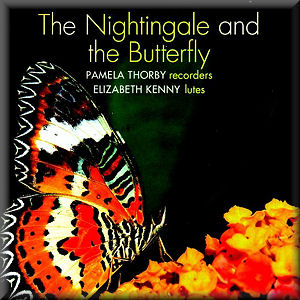 |
 |
|


alternatively
CD:
AmazonUK
AmazonUS
MDT
|
The Nightingale and the Butterfly
Louis DE CAIX D'HERVELOIS (1680-1759)
2e Suite in G [13:55]
Robert DE VISÉE (c.1650-1725)
Passacaille [02:41]
Anne-Danican PHILIDOR (1681-1728)
Sonate pour la flûte à bec in d minor [08:58]
Charles DIEUPART (c.1667-c1740)
Suite No. 1 in A 'pour une flûte de voix' [16:31]
Robert DE VISÉE
Suite in d minor [11:17]
François COUPERIN (1668-1733)
14e Ordre: Le Rossignol-en-amour 03:22]
Charles DIEUPART
Suite No. 6 in f minor 'pour une flûte du quatre' [14:14]
François COUPERIN
14e Ordre: Le Rossignol Vainqueur [02:00]; Double du Rossignol [03:33]
 Pamela Thorby (recorders), Elizabeth Kenny (archlute, theorbo, guitar)
Pamela Thorby (recorders), Elizabeth Kenny (archlute, theorbo, guitar)
rec. 22-24 March 2009, The National Centre for Early Music, York, UK. DDD
 LINN RECORDS CKD341
LINN RECORDS CKD341  [76:41]
[76:41] 
|
|
|
The nightingale and the butterfly are just two of the creatures
which turn up regularly in baroque compositions. The nightingale
was especially popular because of the beauty of its singing.
Characteristic of the butterfly is its velocity - graceful but
also unpredictable. No wonder it is sometimes used as a symbol
for a fickle lover. Both are represented in this programme of
music for recorder and basso continuo. That is to say: the music
on this disc can be played in this scoring. But some pieces
can be played on a range of treble instruments, the choice of
which is left to the performer. There are also pieces for which
the composer has indicated the transverse flute as the first
choice. This doesn't exclude a performance on the recorder,
but sometimes the composer's first choice is also the best.
That is especially the case with the two extracts from the 14e
Ordre of pieces for harpsichord by François Couperin. The
composer suggests the upper part to be played on the transverse
flute. Thanks to its wider dynamic range this instrument seems
better suited to express the subtlety of the nightingale's singing
than the recorder with its quite penetrating sound. It was not
such a good decision to split Le Rossignol-en-amour and
its double into two tracks and play them at different
moments in the programme as they clearly belong together and
are placed next to each other by the composer.
The programme furnishes a nice survey of French music of the
early 18th century. Louis de Caix d'Hervelois is one of the
lesser-known masters. He was a player of the viola da gamba
and was probably a pupil of Marin Marais. Two of his collections
of music are scored for transverse flute and basso continuo.
The 2e Suite in G comes from the second collection, which
was printed in 1731. At this time character pieces were very
popular, and this suite contains three of them. Here we meet
the butterfly: the fourth movement is called 'Papillon', and
it is not surprising that the tempo indication is 'vite'. The
next movement, 'La Lionnoise', could refer to Lyon, where members
of the Caix family were born, to whom Louis probably was related.
'La Fanatique' is appropriately played here with strong accents,
and mostly forte.
Anne-Danican Philidor was a member of the Philidor dynasty of
musicians and composers. His main works are compositions for
the stage. Only two books with pieces for a treble instrument
and basso continuo are known. The choice of instrument is left
to the performer, but in the Sonata in d minor the recorder
is specified. It is notable that two of the five movements are
fugues, and the fourth movement is called "les notes égales
et détachez". This means that notes inégales which
interpreters were often expected to play, are out of order here,
and that the notes should be played staccato.
Charles Dieupart was a composer who, relatively early in his
career, settled in London. He is mainly known for his Six
suittes de clavecin which he published in Amsterdam in 1701.
The next year the same suites were printed in an edition for
a treble instrument and basso continuo. For the treble part
violin or recorder were suggested. The mention of the recorder
comes as no surprise: they were intended for the English market
where the recorder still enjoyed great popularity, in particular
among amateurs. Johann Sebastian Bach copied two of the suites
- those recorded here. For the Suite No. 1 the flûte de voix
is required: the voice flute or recorder in D. The Suite No.
6 asks for the flûte de quatre: the fourth flute or soprano
recorder in B flat.
The music with recorder is interspersed with solo pieces for
theorbo by Robert de Visée. He was a versatile performer, who
played the theorbo, the guitar and the viola da gamba. He is
mainly known as the guitar teacher of Louis XIV. For this instrument
he published two collections, as well as one book with pieces
for the theorbo. The Suite in d minor and the Passacaille
which Elizabeth Kenny plays come from the manuscript Vaudry
de Saizenay, which dates from the end of the 17th century. The
suite contains just one character piece, called 'Ouverture de
la Grotte de Versailles'. The 'grotte' (cave) is illustrated
by strong notes at the theorbo's lower range.
The programme on this disc has been well put together, and the
result is an interesting and very entertaining recital. Pamela
Thorby plays very well, with great rhythmic vibrancy and an
eloquent expression of the character pieces. Elizabeth Kenny
provides fine support on the various plucked instruments, and
delivers excellent performances of the solo pieces by De Visée.
The balance between the recorder and the theorbo could have
been better. The recorder produces a quite penetrating sound,
and as a result the theorbo sounds a shade too much in the background.
Johan van Veen
|
|
|

